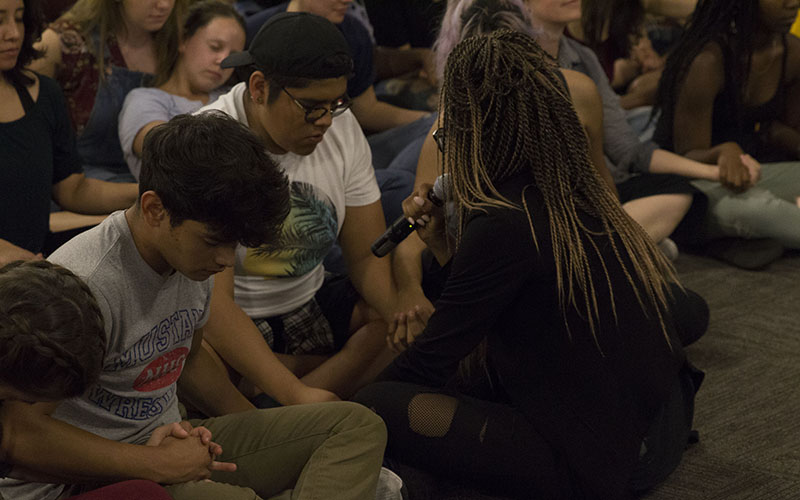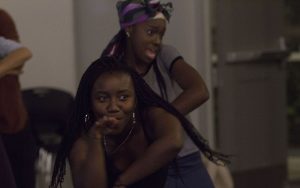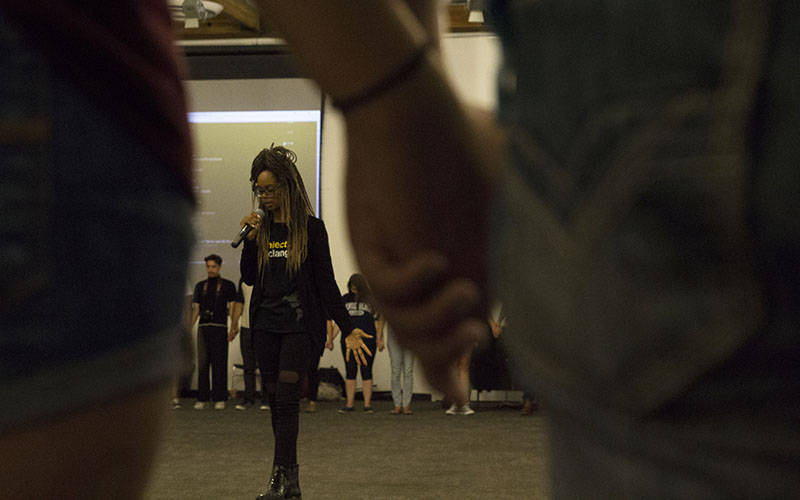PHOENIX — Dance has long been considered a physical form of socialization and fun.
Last week, however, a crowd of more than 250 people gathered in Downtown Phoenix to learn how it could be used for something completely different — activism.
What was expected to be a crowd of 100 people quickly turned into more than 200, as a line stretched outside the A.E. England Auditorium on the Arizona State University downtown campus. A feeling of excitement and electricity could be felt inside the packed auditorium, as attendees awaited to hear from Shamell Bell, a renowned choreographer and one of the core founders of the Black Lives Matter network.
Professor Mathew Sandoval, a close friend of Bell’s, introduced her.
In a half-dance, half-walk, Bell came up to the stage as the audience clapped and shouted in eager anticipation.
Before starting the lecture portion, or ‘radicalized dialogue’ as Belle called it, some ground rules were set.
“I’m not saying that by us doing street dance activism, that we are doing a better form of protest because we’re dancing,” she said. “I don’t want this to be sexy to y’all. I want you to know that we need all types of disruption.”
People responded by clapping and snapping their fingers in agreement.

Attendees raise their fists in agreement with Shamell Bell’s words. (Photo by Lysandra Marquez/Cronkite News).
Bell shared personal anecdotes and videos during the lecture, providing the audience with a brief history of street dance activism, and shared that she was moved to start it after Trayvon Martin’s shooter, George Zimmerman, was allowed to walk free.
In an interview with Cronkite News, Bell shared the importance of participants understanding the history of the movement.
“I tell the background of it because I think it’s really important to have conversations around appropriating,” said Bell, referring specifically to cultural appropriation.
Back in the auditorium, Bell asked the audience to join her in a special chant she referred to as “Assata’s chant.”
“It is our duty to fight for freedom. It is our duty to win. We must love and protect one another. We have nothing to lose but our chains.”
During a short intermission, chairs were quickly moved to the side, opening up the room for the most awaited part of the night.
Once back inside, audience members were asked to form a circle, while Bell stood in the center and led the group in a grounding exercise to prepare them for dancing.

Shamell Bell ends the night with a breathing exercise. (Photo by Lysandra Marquez/Cronkite News).
Holding hands with their heads bowed, participants followed Bell’s instructions, shifting to a lighter mood.
“Four black girls, I need four black girls to join me up here,” shouted Bell, before starting the dance lesson.
Then came the time for Bell to teach popular social dances like the ‘dougie,’ the ‘reject’ and the ‘jerk’, before she broke everyone up into four different groups.
The groups were asked to choreograph dance routines using all the moves Bell had shown them.
Between the laughter, the back-and-forth energy and the collaboration visible among the groups, participants clearly enjoyed working together.
After their 15 minutes were up, each group took the stage to perform one by one.
Bell made it clear to everyone that the night was not about competition — it was about community.
After the event, Susannah Keita, a dance instructor at Grand Canyon University, shared her motivations for attending were both professional and personal.
“I came tonight because I’m actually choreographer and I’m doing a piece about white fragility this semester and I really feel it’s important to be inclusive in my process,” she said.
“I feel charged, I feel ignited. I have a lot of reasons to do this work, not the least of which is my own daughter. She’s African-American, and I fear for her at times, especially because she’s now an adult and I’m not able to monitor her as much. I don’t want her to come into harm’s way.
For Chloe Groom, dancer and herbalist, dancing and activism are not foreign concepts, but the combination is something new.
“I think that what she’s doing in this formula is fresh and you can connect–you can relate to it,” she said. “I think it was really applicable and appropriate for this urban environment, what she is bringing to the table. I’m grateful that I came.”

Groups practice their routines before presenting a final version. (Photo by Lysandra Marquez/Cronkite News).
While many of the attendees enjoyed the opportunity to meet and learn from Bell, Sarra Tekola, a doctoral student at ASU, also took the opportunity to address the creation of a Black Lives Matter chapter in Phoenix.
“There’s not a lot of activism on campus, it feels like a politically dead campus. It’s nice to see this and I hope it inspires people to do other stuff,” she said.
Tekola commented on the impact of having someone like Bell introduce the concept in a place she perceives as being hostile to people of color.
“I think it is important for people to know that because of the issues in our community, a lot of people of color don’t feel safe on the campus, so having her makes people feel better about existing here,” she said.
The event itself was a collaboration between Barrett the Honors College, the Center for the Study of Race and Democracy at Arizona State University and Mathew Sandoval, who is involved with both. He said he is already planning on bringing Bell back for a longer and more extensive workshop.
“This time, I think it was a matter of getting her to kind of contextualize her work in a lecture format and then lead a workshop. I think next time, we’re going to try and do a multi-day dance workshop,” said Sandoval.
At the end of the night, Sandoval made it a point to address the vulnerability it takes to participate in a physical activity like dancing, and further combining it with political activism.
“In a space like street dance activism, you’re actually building community because you’re in a room with other vulnerable people who are being vulnerable because, not everybody likes to move, not everybody likes to dance and feels comfortable,” he said.
“When you start putting some of those moves in your body, you’re breaking down walls because you’re being really real with another person in that space. You get that in dance in a way that you don’t get that in a lot of other art forms.”
